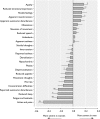Gender differences in outpatients with anxiety disorders: the Leiden Routine Outcome Monitoring Study
- PMID: 25989916
- PMCID: PMC6998770
- DOI: 10.1017/S2045796015000414
Gender differences in outpatients with anxiety disorders: the Leiden Routine Outcome Monitoring Study
Abstract
Background: Data from the general population show higher prevalence of different anxiety disorders in women as compared with men. We analysed gender differences in a naturalistic sample of outpatients with anxiety disorders in a mental healthcare setting.
Method: Routine outcome monitoring data were collected from 1333 patients (age: 18-65; 63.3% women) fulfilling Diagnostic and Statistical Manual of Mental Disorders IV criteria of current anxiety disorder according to the Mini-International Neuropsychiatric Interview between 2004 through 2006. Data included Comprehensive Psychopathological Rating Scale, Brief Symptom Inventory (BSI), Short Form Health Survey (SF-36), Mood and Anxiety Symptom Questionnaire (MASQ). Chi-squared test and t-test were used to compare women with men for variables with parametric distributions, and Mann-Whitney test for non-parametric distribution. Adjustments for potential confounders (age, level of education, ethnicity and comorbidites) were made by logistic regression models (for discrete variables) or analysis of covariance.
Results: The female-to-male ratio (i.e., 844 women, 489 men) for any anxiety disorder was 1.73 : 1 (95% confidence interval [CI]: 1.63-1.83), with the strongest skewness for post-traumatic stress disorder (2.80 : 1) and the smallest one for social phobia (1.18 : 1). Compared with men, women reported more severe self-rating scores on the BSI (on average, the scores were 12.3% higher on 3 of 9 subscales: somatisation, interpersonal sensitivity and anxiety), SF-36 (self-reported generic health status was lower on 5 of 8 subscales: physical functioning, social functioning, physical problems, vitality and bodily pain) and MASQ (on average, the scores were 6.6% higher on 4 of 5 subscales: anxious arousal, general distress, general distress depression, general distress anxiety). On the contrary, no gender difference was found in the severity of anxiety symptoms measured by the Brief Anxiety Scale. Women were more likely to suffer from comorbid depression and bulimia nervosa, and less likely from substance abuse.
Conclusions: In a treatment-seeking population the prevalence rate of anxiety disorders was 1.7 times higher in female compared with men. Female outpatients were more severely affected on self-rated but not on observer-rated scales.
Keywords: Epidemiology; gender differences; outpatient psychiatry; panic disorder; post-traumatic stress disorder.
Figures


Similar articles
-
Reference values for generic instruments used in routine outcome monitoring: the Leiden Routine Outcome Monitoring Study.BMC Psychiatry. 2012 Nov 21;12:203. doi: 10.1186/1471-244X-12-203. BMC Psychiatry. 2012. PMID: 23171272 Free PMC article.
-
Measuring treatment outcome in patients with anxiety disorders: A comparison of the responsiveness of generic and disorder-specific instruments.J Anxiety Disord. 2019 May;64:55-63. doi: 10.1016/j.janxdis.2019.04.001. Epub 2019 Apr 6. J Anxiety Disord. 2019. PMID: 30986658
-
Predicting outcomes of mood, anxiety and somatoform disorders: the Leiden routine outcome monitoring study.J Affect Disord. 2012 Dec 15;142(1-3):122-31. doi: 10.1016/j.jad.2012.03.051. Epub 2012 Jul 26. J Affect Disord. 2012. PMID: 22840464
-
Association of age and gender with anxiety disorders in older adults: A systematic review and meta-analysis.Int J Geriatr Psychiatry. 2019 Mar;34(3):397-407. doi: 10.1002/gps.5035. Epub 2018 Dec 10. Int J Geriatr Psychiatry. 2019. PMID: 30444008
-
Anxiety disorders: sex differences in prevalence, degree, and background, but gender-neutral treatment.Gend Med. 2007;4 Suppl B:S178-93. doi: 10.1016/s1550-8579(07)80057-x. Gend Med. 2007. PMID: 18156102 Review.
Cited by
-
A biopsychosocial model of severe fear of COVID-19.PLoS One. 2022 Feb 28;17(2):e0264357. doi: 10.1371/journal.pone.0264357. eCollection 2022. PLoS One. 2022. PMID: 35226661 Free PMC article.
-
Gender differences in psychiatric outpatients: a before and during COVID-19 pandemic study in general hospitals from China.Ann Gen Psychiatry. 2022 Sep 7;21(1):35. doi: 10.1186/s12991-022-00412-3. Ann Gen Psychiatry. 2022. PMID: 36071451 Free PMC article.
-
Toxoplasma gondii Infection and Mixed Anxiety and Depressive Disorder: A Case-Control Seroprevalence Study in Durango, Mexico.J Clin Med Res. 2016 Jul;8(7):519-23. doi: 10.14740/jocmr2576w. Epub 2016 May 29. J Clin Med Res. 2016. PMID: 27298660 Free PMC article.
-
Evaluation of psychiatric conditions in asymptomatic outpatient clinic patients.PLoS One. 2025 Feb 25;20(2):e0319168. doi: 10.1371/journal.pone.0319168. eCollection 2025. PLoS One. 2025. PMID: 39999119 Free PMC article.
-
The mediating role of resilience on the association between family satisfaction and lower levels of depression and anxiety among Chinese adolescents.PLoS One. 2023 May 25;18(5):e0283662. doi: 10.1371/journal.pone.0283662. eCollection 2023. PLoS One. 2023. PMID: 37228075 Free PMC article.
References
-
- Alnaes R, Torgersen S (1988). DSM-III symptom disorders (Axis I) and personality disorders (Axis II) in an outpatient population. Acta Psychiatrica Scandinavica 78, 348–355. - PubMed
-
- Altemus M (2006). Sex differences in depression and anxiety disorders: potential biological determinants. Hormones and Behavior 50, 534–538. - PubMed
-
- Bekker MH, Van Mens-Verhulst J (2007). Anxiety disorders: sex differences in prevalence, degree, and background, but gender-neutral treatment. Gender Medecine 4(Suppl. B), S178–S193. - PubMed
-
- Bijl RV, Ravelli A, Van Zessen G (1998). Prevalence of psychiatric disorder in the general population: results of The Netherlands Mental Health Survey and Incidence Study (NEMESIS). Social Psychiatry and Psychiatric Epidemiology 33, 587–595. - PubMed
-
- Bogetto F, Venturello S, Albert U, Maina G, Ravizza L (1999). Gender-related clinical differences in obsessive-compulsive disorder. European Psychiatry 14, 434–441. - PubMed

